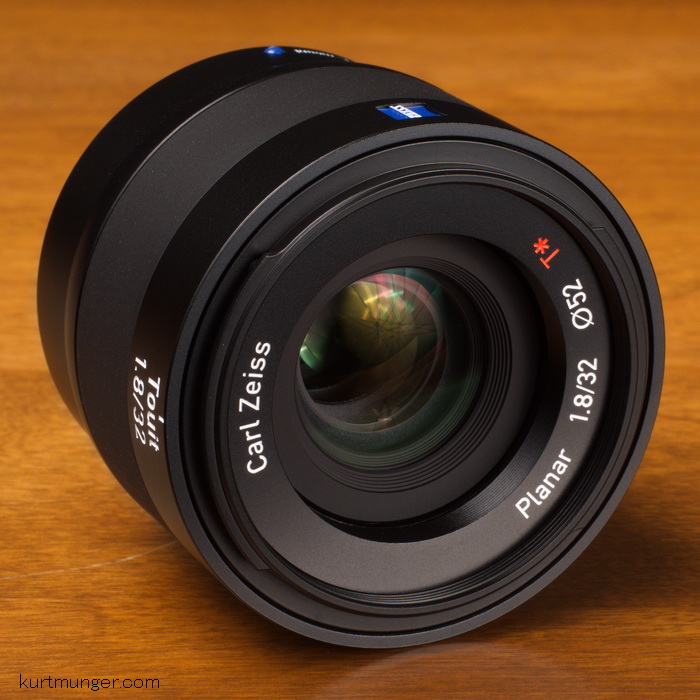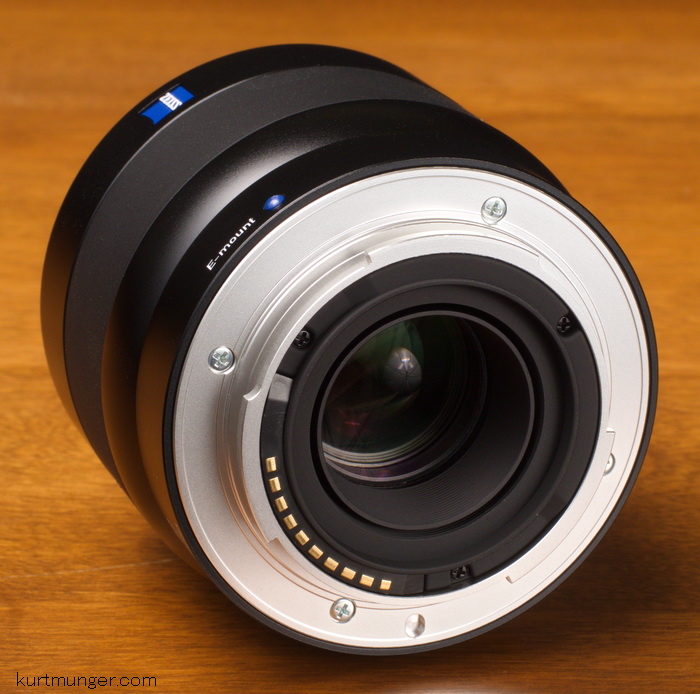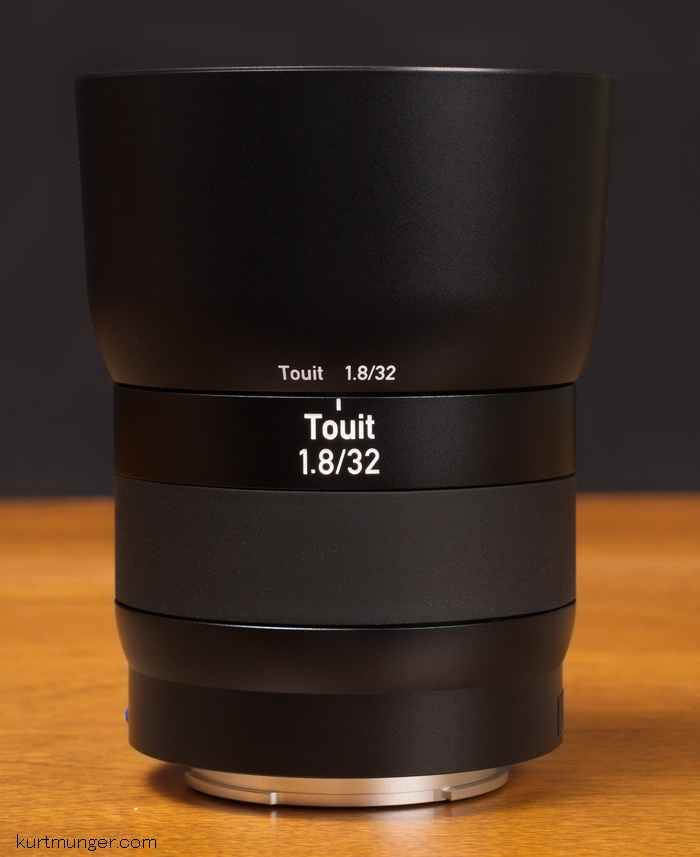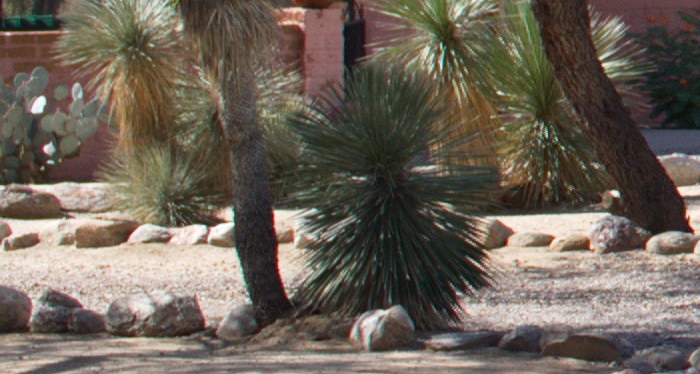|
Full review of the Zeiss Touit 32mm F/1.8 ‘E’ mount lens. The Sony NEX-C3 was used for this review. For a better understanding of terms and methods used in this review, go here.
The usual center, mid-section and corner crops are located at the very bottom of the page.
Introduction.
The Zeiss Touit 32mm F/1.8 became available in early 2013, and is currently made for Sony e-mount APS-C, and Fuji X-mount camera systems. I’ll be reviewing the Sony version here.
Zeiss enters the autofocusing lens market with two initial offerings; the 12mm f/2.8, and 32mm F/1.8 lenses. So far, the Touit line is made for APS-C sized sensors only. Apparently, Touit is the name of a cool bird (Raphus cucullatus), and is pronounced ‘do-it’. I’m not sure why Zeiss decided on the focal lengths here, the 12mm has the same coverage as an 18mm in 135 film format, and the 32mm about 50mm. Both Sony and Fuji have 35mm lenses out that are quite good, and priced less; and Fuji even has an excellent 14mm lens, so I’m not sure these focal lengths were a super smart choice by Zeiss. However, Sony is lacking in an ultra-wide angle prime, so I guess it makes some sense, but at a price point of $1250, it will probably be out of reach for most E and X system owners.
Fit and finish are good. The lens appears to be clad in high quality plastic with a less expensive dull pot-metal mount. The focusing ring is covered in rubber that collects dust easily, but cleans up easily too. The hood fits on the lens with a snug fit when attached in the forward shooting mode, and in the storage (reversed) way too, unlike the 12mm, which attaches poorly in the reverse way. The lens is made in Japan.
The aperture blades are very noisy for some reason; check it out yourself by switching back and forth between review and live mode with AF turned off.
The ‘Planar’ design for this lens is 8 elements in 5 groups, the same as the Sony Zeiss 50/1.4, but the actual optical designs for each lens varies considerably.
There is no mention of any exotic glass used in the construction of the lens.
Filter size is 52mm. So far, Sony has zero lenses that use this size, but Fuji has two at the time of this review, the 35/1.4 and 18/2. Focusing. This lens auto-focuses quickly and mostly accurately, and has a somewhat loud focusing motor, and sounds like an electric toothbrush when focusing; tough luck for you video nuts out there as the noise will probably be picked up by the cameras mic. The front filter ring doesn’t turn when focusing, so your grads and polarizers will work great. The focusing ring is easy to turn, and is damped about right. The focus ring rotates about 270° from close in to infinity, so you have plenty of room for getting your subject in perfect focus. Turn the focusing ring clockwise for close subjects, counter-clockwise for infinity.
Note on focusing: the front group moves in and out as you focus, and focusing at longer distances allows a gap to form around the front element that extends inside the lens itself, (see product shot of lens front) so be sure and use a clear filter if you’re in a dusty or wet environment. At close focusing distances, the front group is about even with the lens retainer ring, but still will allow tiny stuff to get inside.
In the box is the lens, front and rear caps, plastic solid hood, and owner’s manual.
Requisite product shots.
General information and specifications.
Optical qualities summary.
Lens flare/ghosting. Good control of flair, average control of ghosting. See examples below.
Light fall-off. Good control here. See samples below.
Color fringing (CA). Average control of lateral, and some axial type at F/1.8-2.8, and mostly gone at F/4, samples below.
Bokeh. Harsh wide open, but smooths out nicely at F/2.8. See crops below.
Color. Seems about the same as Sony lenses.
Close-up filter. Not tested.
Coma. Significant amount at F/1.8, but mostly gone at F/2.8.
Regular filters: don’t cause any additional light fall-off.
Filter size. 52mm. Sony doesn’t use this size, but Fuji does.
Distortion. moderate barrel type.
The pattern is moderate barrel, distortion correction sliders are able to almost eliminate it.
Bokeh samples.
Bokeh looks harsh at very wide apertures, but smooths out nicely at F/2.8 and smaller. I focused on the hanging (and swinging) chain about 5′ (1.7m) away, with the trees in the background about 12′ (4m) away.
Light fall-off
There are no real problems with light fall-off or ‘corner shading’ with this lens, even at the widest aperture.
Flare and Ghosting
These samples show a moderate amount of ghosting with the sun in the image, but contrast holds up well. With a setting sun, ghosts don’t show up much. Ghosting colors are green, blue (haven’t see that color in a while) and magenta.
Axial color fringing.
Axial color fringing can occur anywhere in the image, but goes away as you stop down the aperture. I see some magenta around the highlights at F/1.8, but it’s mostly gone by F/4. Exposure differences are from light fall-off.
Lateral Color fringing sample.
Lateral color fringing is noticeable along the sides of the image, where red shows up along the tree trunk and rocks, as well as cyan on the other side. It’s easy to correct this in newer versions of Lightroom when shooting in RAW. This crop comes from the last 700 pixels of the middle left side of the image.
Coma samples.
Coma sometimes shows up in the corners of fast (F/1.4-2.8) wide to medium length lenses, and takes the forms of birds, bats, or jets! The Zeiss 32mm F/1.8 has moderate to strong coma at F/1.8, and almost nothing at F/2.8. Crop is of a small Christmas tree at the very corner of the image, about 20′ (7m) away. See how the corners sharpen up as you stop down the aperture. Let’s check out the close-focus capabilities of this lens.
The sample shot was taken with the Sony NEX-C3 16.2MP camera, so don’t compare it with others that were taken with 12 or 24mp sensor cameras. The subject is a standard US stamp, 0.87″x 1.0″ or 22mm x 25mm. The shot was taken as close to the subject as focusing allowed; in this case 8.25″” (210mm), measured from the front of the lens barrel to the subject.
The Zeiss 32mm F/1.8 has a reproduction size of 1:9, which is quite small, and almost identical to the Zeiss 12/2.8 coverage. F/5.6 was the sharpest close focus aperture. The close focus shot is pretty sharp with good contrast.
Zeiss says the coverage at close range is 8.43″ x 5.59″ (214 x 142mm)
Conclusion
Overall, the Zeiss 32mm F/1.8 lens turned in a great performance, producing very sharp images with nice color and contrast from F/2.8-5.6. At F/1.8-2.8, the centers seem noticeably sharper than the Sony 35/1.8 OSS, but I didn’t directly compare them as I don’t have the Sony right now. I did use the same scene for assessing sharpness as the Sony Zeiss 50/1.4, but don’t compare those crops as they were taken with the 24mp Sony A900.
Like the other Zeiss Touit lens I reviewed recently, there isn’t much to complain about, but since I feel obligated to point out some problems, I will! One, the focusing motor is loud, so you video people may want to look more carefully at the Sony 35/1.8, it has OSS, plus a super quiet focusing motor. The extra sharpness you’ll get with the Zeiss at the max aperture probably won’t matter, but focusing noise will. Also, if you’re a street shooter in low light, the Sony 35/1.8 OSS might allow a two stop advantage when hand held, so I’d guess that would more than makes up the difference in sharpness—Sony at F/2.8-4 with a shutter speed of 1/10 or 1/5, the Zeiss at F/1.8 with a shutter speed of 1/25 etc. Two; (a combination of issues), coma is strong at F/1.8, ghosting and color fringing (both types) control is just average, which is slightly disappointing, but color fringing is easy to remove in photo editing software like newer versions of Adobe Lightroom when shooting RAW. Lastly, the price, it’s quite expensive at $900, especially when you consider the build quality, it’s good, but not really what you’d expect for that speed and focal length.
The Zeiss 32mm F/1.8 performs very well optically, but does lack some important features like a quiet focusing motor and optical stabilization. The current street price is around $900, that’s double the Sony 35/1.8 OSS. If you demand critical sharpness, especially at wide apertures, the Zeiss may be worth it if you don’t need OSS and video. If you do shoot video, or rarely use a wide aperture, the Sony 35/1.8 OSS would be a better choice in my opinion. |
Sample crops from the centers, mid-sections and corners.
|
Center
|
Mid-section
|
Corner
|
|
|
F/1.8
|
 |
 |
 |
|
F/2
|
 |
 |
 |
|
F/2.8
|
 |
 |
 |
|
F/4
|
 |
 |
 |
|
F/5.6
|
 |
 |
 |
|
F/8
|
 |
 |
 |
|
F/11
|
 |
 |
 |
|
The centers are sharp wide open, but don’t appear any sharper at F/2, (which I included for indirect comparisons with other lenses), however, stopping down to F/2.8 brings a large gain in sharpness across the entire image, along with being brighter as a result of less vignetting. The mid-sections look good wide open also, but again, there’s a noticeable gain by stopping down to F/2.8. Closing down the aperture to F/4 doesn’t do much more for the centers and mid-sections, but the corners look slightly sharper. Resolution wise, the lens seems to max out at F/4, but the far corners will see a slight improvement at F/5.6 at longer focusing distances. The optical performance is reminiscent of the Sony CZ 24/1.8.
Exposure differences are from light fall-off. Manual focusing was used, along with manual white balance.
The subject is a house about 303′ (92m) away.
Please check out the Zeiss Touit 32mm F/1.8 lens at B&H Photo and help support the site! |




























